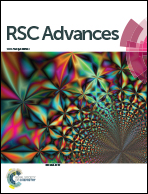Syntheses, structures, and properties of six new coordination polymers constructed from N-heterocyclic multicarboxylic acids†
Abstract
Six new coordination polymers, {[Zn2(Hpdtc)2(Hbpe)2]·5H2O} (1), [Zn2(pdtc)(bpe)1.5]n (2), [Zn(Hpztc)(Hbpe)(H2O)] (3), {[Zn2(pztc)(bpe)2(H2O]·9H2O}n (4), {[Cu2(pdtc)(bpy)(H2O)2]·3H2O}n (5) and {[Cu2(pdtc)(bpy)(H2O)2]·2H2O}n (6) [H4pdtc = pyridine-2,3,5,6-tetracarboxylic acid, H4pztc = pyrazine-2,3,5,6-tetracarboxylic acid, bpy = 4,4′-dipyridine, and bpe = 1,2-bis(4-pyridyl)ethene], have been synthesized under control by modifying the reaction conditions. Their structural diversities range from zero-dimensional (0D) (1, 3), two-dimensional (2D) (2, 5), to porous three-dimensional (3D) networks (4, 6). The pH values of the reagents of 1 and 3 are around 3, which results in the ligands of 1 and 3 being partly protonated. Both 1 and 3 show 0D structures. So we tried to modify the pH value to improve the structures. 2 and 4 were synthesized at higher pH values (5.8, 5.1). 2 and 4 have 2D layer structure and 3D pillar-layered framework, respectively. 5 and 6 were synthesized from the same reagents, 5 was synthesized at room temperature, while 6 was obtained under hydrothermal conditions. The coordination environment of Cu(II) centers in 6 is similar to 5 except that one oxygen atom from a water molecule for Cu1 in 5 is replaced by the oxygen atom from the pdtc4− ligand in 6, which results in different structures: 5 shows 2D network structure, 6 has a 3D porous framework. The PXRD, thermal stabilities and luminescent properties of these complexes were investigated in detail.


 Please wait while we load your content...
Please wait while we load your content...